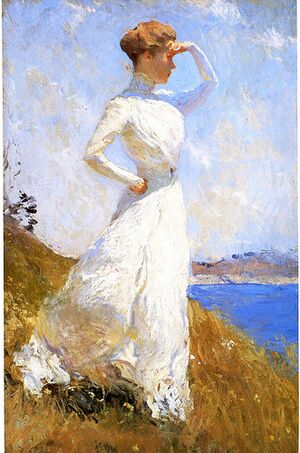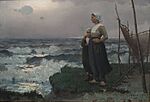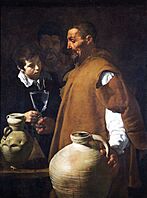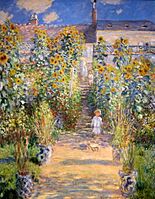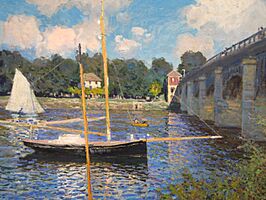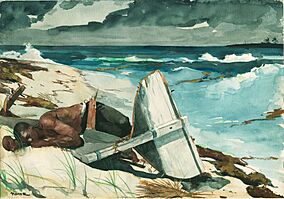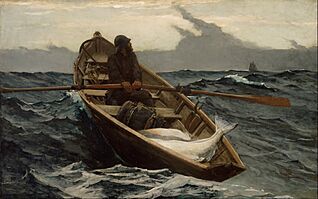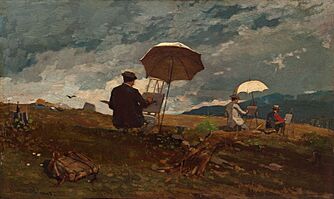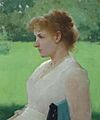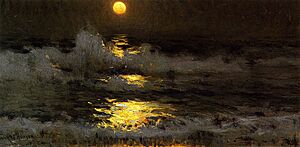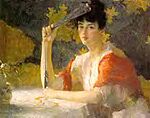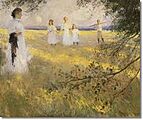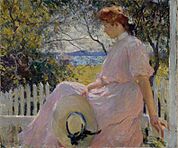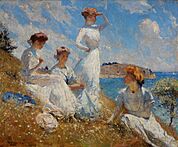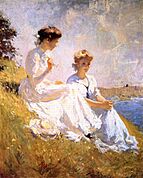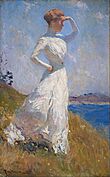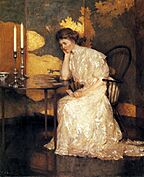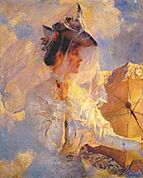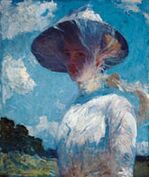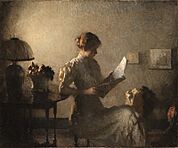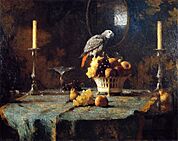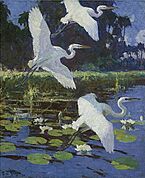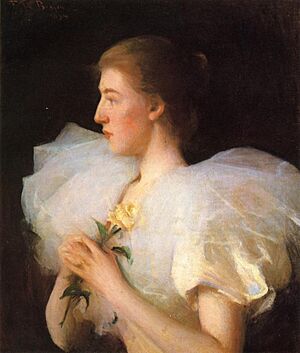Frank Weston Benson facts for kids
Quick facts for kids
Frank Weston Benson
|
|
|---|---|
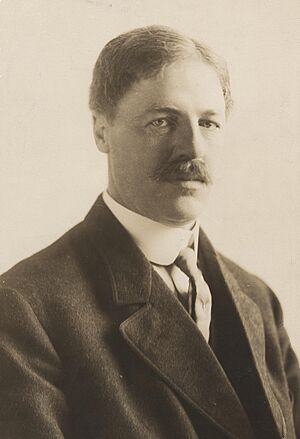
circa 1895
|
|
| Born | March 24, 1862 |
| Died | November 15, 1951 (aged 89) Salem, Massachusetts, US
|
| Education | School of the Museum of Fine Arts, Boston, Académie Julian Paris |
| Known for | Impressionist painting |
Frank Weston Benson (March 24, 1862 – November 15, 1951) was an American artist. He was born in Salem, Massachusetts. Benson was famous for his realistic portraits. He also painted Impressionist pictures, watercolors, and etchings.
He started by painting portraits of important families. He also created large murals for the Library of Congress. Some of his most famous paintings show his daughters outdoors. These were often made at his summer home in North Haven, Maine. Frank Benson also painted many pictures of wildfowl (wild birds) and landscapes. He used oil, wash, and watercolor.
In 1880, Benson began studying art. He went to the School of the Museum of Fine Arts, Boston. Later, in 1883, he traveled to Paris. There, he studied at the Académie Julian. He became a respected teacher at the Boston Museum School. Benson also helped start important art groups. These included the Ten American Painters.
Contents
Biography
Early life
Frank Weston Benson was born into a well-known family. His father, George Wiggin Benson, was a cotton broker. His mother, Elisabeth Poole, came from families who helped found Salem, Massachusetts. Frank loved the sea, just like his grandfather, Captain Samuel Benson.
When he was 12, Frank got a sailboat. He explored rivers and marshes. He even raced his brother, John Prentiss Benson. Their parents encouraged them to learn. They gave the children money for hobbies. This included dance classes and photography. Frank and his brother also enjoyed sports, fishing, and hunting.
Frank's father taught him to hunt birds. They hunted shore birds and wildfowl. Frank spent almost every weekend hunting or fishing. He once wrote to a friend about their adventures. He described chasing birds in Salem Harbor. They would talk for hours about every bird they saw.
Frank's brother, John Prentiss Benson, also became an artist and architect. Their mother may have inspired them. Frank said she had a special room. She would go there to paint and "forget about the rest of the world."
Art studies
Frank Benson loved birds and hunting. He first wanted to be an ornithological (bird) illustrator. When he was 16, he painted Rail. This was one of his first oil paintings. He made it after a hunting trip.
In 1880, he started studying at the School of the Museum of Fine Arts, Boston. There, he met other artists. These included Joseph Lindon Smith and Edmund Charles Tarbell. Benson taught drawing classes in Salem. He also painted landscapes in the summer of 1882.
For his 21st birthday, his parents gave him $2,000. This was for studying art in Europe. He went to Paris in 1883. He studied at the Académie Julien with Edmund Tarbell. One of his teachers, Gustave Boulanger, told him: "Young man, your career is in your hands... you will do very well." After Paris, Benson visited England. He saw his painting "After the Storm" on display. He also spent time in Italy, Belgium, Germany, and Brittany.
Artistic influences
Benson was greatly inspired by old masters. These included Johannes Vermeer and Diego Velázquez. Vermeer was a Dutch artist from the 1600s. He was known for painting light beautifully. Velázquez was a Spanish painter.
- Artists who inspired Benson
Impressionism also shaped Benson's style. He especially liked the work of Claude Monet. Benson used Monet's bright colors and brush strokes. He was good at showing "reflected light" in his paintings. Yet, he still kept some clear details. Benson's art showed American people with "grace, dignity, and elegance."
- Impressionist art that influenced Benson
Some critics said Benson's watercolors were like those by Winslow Homer.
- Winslow Homer's influence
Benson did not try new art styles like Cubism. He stuck to his traditional American Impressionist style. Later in his career, some criticized his "pretty" paintings. So, Benson turned to nature. Birds became his main subjects instead of people.
Family life and teaching
In 1884, Benson painted in France. There, he met Ellen Perry Peirson. She was the daughter of family friends from Salem. They got married in 1888. They had four children: Eleanor (born 1890), George (born 1891), Elisabeth (born 1892), and Sylvia (born 1898).
Benson became an art teacher in 1886. He taught at the Portland School of Art. In 1889, he started teaching at the School of the Museum of Fine Arts, Boston. By 1890, he was head of the Painting department. The school became very popular under his leadership. Benson was a favorite teacher. His students called him "Cher Maitre" (Dear Master). He taught until 1913.
Artworks
An art historian named William H. Gerdts praised Benson's work. He said Benson painted "some of the most beautiful pictures ever executed by an American artist." His art showed youth and hope. It also captured real parts of life at the time. Benson's work was even part of art competitions at the 1932 Summer Olympics and 1936 Summer Olympics.
Realistic paintings
In 1886, Benson opened his first art studio in Salem. He started painting portraits. He took this work very seriously. He believed a painter must deeply understand their subject. This helps the viewer truly see and feel the painting.
In 1888, Benson opened a studio in Boston. He shared it with Edmund C. Tarbell. Benson's first show in New York was a success. His work showed the influence of Realism.
Benson spent several summers in Dublin, New Hampshire. He painted with his friend Abbott Thayer. By the early 1890s, he started using his family as models. Benson realized that design was key to painting. His works from this time show strong patterns and shapes.
-
Portrait of Margaret Washburn, 1886
-
Thalia, mural, 1900, Library of Congress
Impressionist paintings
Benson joined the "Ten American Painters" group in 1898. After this, he focused on plein-air Impressionism. This means painting outdoors.
The Benson family spent summers away from Boston. From 1893 to 1900, they were in New Castle, New Hampshire. Here, Benson made his first Impressionist paintings. These included Children in the Woods and The Sisters. The Sisters was very popular. It won awards in the U.S. and Paris. This made Benson famous for his family paintings.
Later, the Bensons spent summers on North Haven Island in Maine. This was at Wooster Farm. Benson painted many Impressionist works of his family there. The summer home had great views of the bay. There were orchards, fields, and woods nearby.
Like French Impressionists, Benson focused on light. He told his daughter Eleanor, "I follow the light, where it comes from, where it goes." One critic said his paintings glowed and shimmered with golden light.
Benson was a leader in American Impressionism. He taught art and was part of art groups. In 1898, Benson and nine other artists formed "Ten American Painters". They held yearly shows in New York City. They became known as the American Impressionists.
Wildlife art
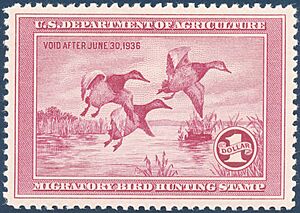
Before his Impressionist family paintings, Benson made many seascapes and landscapes. He used different art forms to show his love for wildlife. These included wash, watercolor, oil, lithography, and etching. A museum curator said Benson was unique. He mastered many different art forms and subjects. He was always interested in light.
Benson's first goal was to be a bird illustrator. Birds were the main subjects of his washes, etchings, and watercolors. He helped start the Essex County Ornithological Club. He was its president for 18 years. He even designed the club's seal. In 1935, he painted ducks for the second Federal Duck Stamp. This stamp helps protect wild birds and their homes.
Wash paintings
- In the 1890s, Benson started using black-and-white wash. He did this at his hunting cabin in Cape Cod. These artworks were very popular. He could not keep up with the demand for them.
Etching
- In 1914, Benson started etching as a hobby. It was a complex technique. He had to master it to get the right effect. In 1915, he showed his etchings of wild birds for the first time. People loved them. Benson started focusing more on landscapes with wildlife. This came from his love of hunting and fishing. He made many etchings and sold them well.
He became as famous for his etchings as for his paintings. A critic called him the "best known and most popular etcher in the world." Benson told one of his daughters that etching was full of "fascinating possibilities." He is known as one of the best printmakers of the 20th century. He helped make wildlife prints a special art style.
Watercolors
- Benson started painting watercolors in 1921. This was during a fishing trip in Canada. Many of his watercolors came from hunting trips in Cape Cod. They also came from salmon fishing trips in Canada. Critics compared his watercolors to those by Winslow Homer. One critic said Benson's work showed a love for the wild. He also had a quick, sure touch. Benson created more than 500 watercolors in his life.
Oil paintings
- Benson also painted wildlife scenes in oil. Examples include Hunter in a Boat (1915) and Twilight (1930).
Gallery
Exhibitions and shows
Frank Benson's art was shown in many places.
- 1885 - After the Storm was shown at the Royal Academy in London.
- 1889 - He won first prize for Orpheus at the National Academy of Design in New York.
- 1891 - His first solo show was in Boston.
- 1894 - He had his first known wildfowl exhibition.
- 1898 - He was part of the first exhibition of the Ten American Painters in New York City.
- 1899 - His Impressionist painting Children in the Woods was shown.
- 1900 - The Sisters won a silver medal at the Paris Exposition Universelle.
- 1912 - He showed black and white wash drawings for the first time.
- 1913 - His first solo show of wildfowl wash drawings was in Boston.
- 1915 - His etchings were shown for the first time.
- 1916 - His etchings were shown outside the U.S. at the British Museum.
- 1922 - His watercolors were shown in New York, Boston, and Cleveland.
- 1945 - His last solo etching exhibition was in New York.
- 1950 - His final exhibition was at the Pennsylvania Academy of the Fine Arts.
His work was also shown in special past exhibitions. These included shows at the Corcoran Gallery of Art and the Museum of Fine Arts, Boston. The Boston museum show was so popular it broke attendance records.
Awards and recognition
Benson started winning awards in the 1890s. After 1900, he won awards for his Impressionist paintings. His wildlife watercolors and etchings also won awards in the 1920s and 1930s. He kept winning awards until he was 86. In 1914, a newspaper called him "America's Most Medalled Painter."
Some of his awards include:
- 1889 - Third Hallgarten Prize for Orpheus.
- 1891 - Thomas B. Clark Prize.
- 1900 - Silver Medal at the Paris Exposition Universelle for The Sisters.
- 1903 - First Prize, Carnegie Prize.
- 1922 - Frank G Logan prize for Still Life.
- 1924 - Frank G Logan prize.
He received an honorary degree from Tufts University in 1930. In 1945, he was chosen for the American Academy of Arts and Letters.
Organizations
Frank Benson was a member of several important art groups:
- 1888 - He became a member of the Society of American Artists.
- 1897 - He was elected to the National Academy of Design.
- 1898 - He was a founding member of the American Academy of Arts and Letters.
- 1914 - He helped found The Guild of Boston Artists. He was president for 13 years. This group helped local artists show their work.
- 1916 - He was a founding member and first president of the Essex County Ornithological Club.
- 1926 - He was elected a Fellow of the American Academy of Arts and Sciences.
Images for kids
See also
- List of works by Frank Weston Benson


